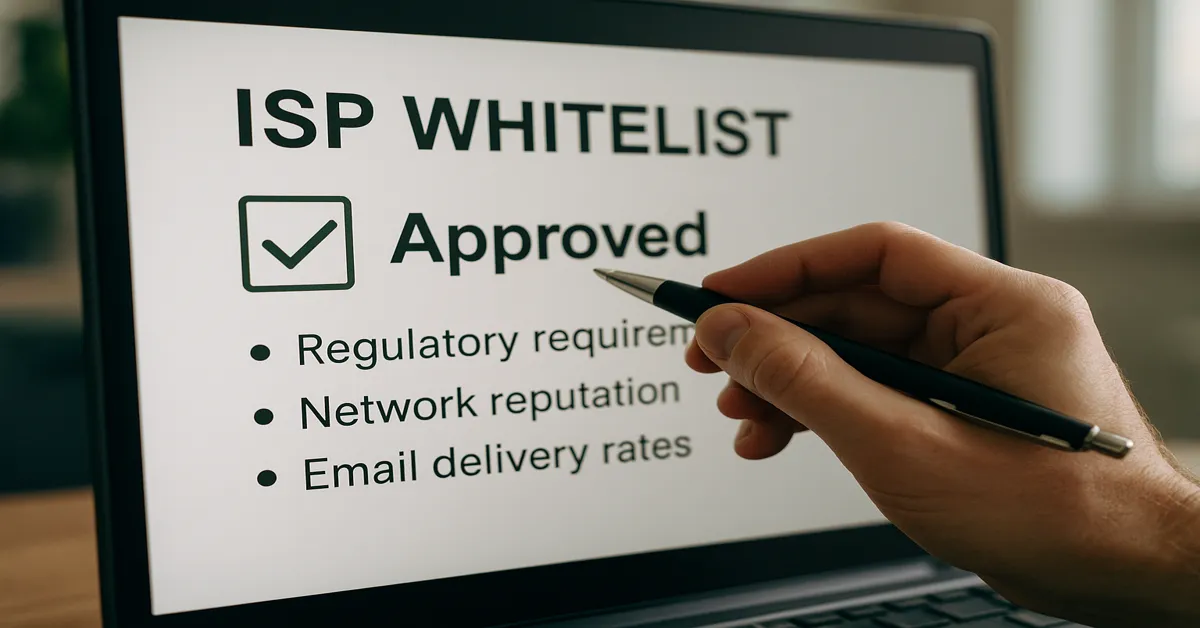If you’ve ever encountered a website that loads for everyone but not for you, or if an app behaves differently depending on your internet provider, you may be experiencing the effects of an ISP whitelist. In a digital world that champions openness, the term can feel unsettling. But what exactly is an ISP whitelist? How does it function, and why is it becoming increasingly relevant in the age of cybersecurity, data sovereignty, and internet regulation?
In this article, we break down the concept of an ISP whitelist: its purpose, implications, technical structure, risks, benefits, and the growing public discourse around who decides what gets through the gate.
What Is an ISP Whitelist?
An ISP whitelist is a set of internet resources—such as websites, IP addresses, or domain names—that an internet service provider (ISP) explicitly allows its users to access. Everything not on the whitelist is blocked or restricted, either by default or due to specific policy rules.
While most users are familiar with blacklists—which block certain sites—whitelisting flips the model: only approved destinations are permitted, and everything else is inaccessible unless manually added to the list.
ISPs may apply whitelisting in specific use cases such as:
- Parental controls
- Corporate or school networks
- Government-regulated internet environments
- Zero-rating services
- Disaster scenarios or emergencies
This controlled access model is not inherently malicious, but in the wrong hands—or without transparency—it raises serious ethical and regulatory concerns.
How Does ISP Whitelisting Technically Work?
An ISP can implement a whitelist at several network layers. Here’s how the process typically unfolds:
1. DNS Filtering
At the Domain Name System (DNS) level, ISPs can configure DNS resolvers to only respond to certain domain queries. All other domain lookups result in a failed resolution.
- Pro: Easy to implement
- Con: Can be bypassed using external DNS services (unless those too are blocked)
2. IP-Based Filtering
More sophisticated ISPs deploy IP-level whitelisting, where traffic to unapproved IPs is dropped or redirected.
- Pro: Harder to circumvent
- Con: Blocks services hosted on shared IPs, causing collateral damage
3. Proxy Gateways
In heavily filtered environments (e.g., school networks or certain countries), all user requests pass through a transparent proxy that checks each URL against an approved whitelist before passing it along.
4. Deep Packet Inspection (DPI)
The most intrusive method, DPI inspects the contents of data packets and enforces access based on destination, content type, or application signature.
- Used in: Authoritarian regimes or high-security enterprise environments
Use Cases Where ISP Whitelisting Is Applied
1. Schools and Universities
To ensure safe browsing environments, school networks often whitelist educational and government-approved content, blocking games, social media, and explicit material.
2. Enterprise Environments
Corporations often whitelist only the websites necessary for work to limit distractions, reduce malware risk, and control data leaks.
3. Developing Regions with Sponsored Internet
In areas where data is expensive, telecom providers may partner with platforms (like Facebook Free Basics) to offer a limited whitelist of websites that can be accessed without data charges.
4. Censorship and Political Control
Governments may enforce ISP whitelisting to control narratives, block dissident content, or regulate access to foreign information. This model has been observed in countries like Iran, North Korea, and Turkmenistan.
ISP Whitelisting vs. Blacklisting: A Key Distinction
| Feature | Whitelisting | Blacklisting |
|---|---|---|
| Default Behavior | Everything blocked unless allowed | Everything allowed unless blocked |
| Flexibility | Rigid and selective | Flexible but reactive |
| Implementation | High administrative overhead | Simpler to scale |
| Common Use Case | Secure environments, censorship | Malware control, explicit content bans |
Whitelisting offers greater control but comes with significant responsibility, requiring ongoing maintenance and posing risks to openness.
Benefits of ISP Whitelisting
1. Enhanced Security
In environments where data leakage or malware risks are high, whitelisting offers a proactive defense by eliminating unknown threats before they reach the user.
2. Productivity Management
Organizations and schools use it to restrict non-essential browsing and keep users focused on task-specific sites.
3. Bandwidth Optimization
By limiting traffic only to approved domains, ISPs or admins can prevent network congestion, especially in low-resource environments.
4. Legal and Ethical Compliance
In certain jurisdictions, ISPs must comply with child protection laws or national security directives—whitelisting is one way to meet those legal obligations.
Concerns and Controversies Surrounding ISP Whitelisting
1. Free Speech and Access to Information
When only a select number of websites are approved, users lose agency over what they can access. This becomes problematic in regions with government control over ISP-level filtering.
2. Net Neutrality Violations
Whitelisting violates the principle of equal access, especially when ISPs favor partners or sponsors (zero-rating) while excluding competitors or independent creators.
3. Market Distortion
Startups and small publishers suffer if not included on ISP whitelists, making it harder to reach audiences, especially in emerging markets.
4. Lack of Transparency
In most cases, users don’t know what’s being blocked. Whitelisting decisions are rarely public, leading to distrust and accusations of manipulation.
The Role of Whitelisting in Net Neutrality Debates
One of the most heated debates in internet policy revolves around net neutrality—the idea that all data should be treated equally, regardless of source.
ISP whitelisting enters this debate when:
- Certain platforms are favored (e.g., free access to Facebook but not competing apps)
- ISPs throttle or block access to non-whitelisted services
- Consumer choice is influenced not by quality or relevance, but by availability
In 2016, India’s telecom regulator famously banned Free Basics (a whitelisting program by Facebook) for violating net neutrality. It was a landmark moment that revealed how well-intentioned whitelisting can backfire if not properly regulated.
Real-World Examples and Case Studies
1. Facebook Free Basics (India and Africa)
- Objective: Provide free internet access to basic services like news, health, and education
- Mechanism: Whitelist a limited number of websites with no data charges
- Outcome: Massive backlash; banned in India, still active in some African nations
2. Iran’s National Information Network
- Offers a separate domestic internet with whitelisted Iranian sites
- Blocks access to global internet during periods of unrest
- Raises serious concerns about surveillance and global disconnection
3. Corporate Firewall at Fortune 500 Firm
- Only company-approved tools and sites whitelisted
- Employees use VPNs to bypass during breaks, citing mental fatigue and lack of flexibility
- Security vs. morale: a classic tradeoff
How Users Can Detect ISP Whitelisting
Most users won’t know they’re under a whitelist unless they look for signs. Here’s how to tell:
- Only specific websites load, while others time out or fail to resolve
- Using a VPN restores full access, indicating ISP-level filtering
- Changing DNS settings does not fix the issue, suggesting deep filtering
Tools like Traceroute, WHOIS, or network diagnostic tools can help confirm if access restrictions are happening upstream.
Ethical Whitelisting: Can It Be Done Right?
Yes—if it’s transparent, opt-in, and user-configurable.
Best Practices for Ethical ISP Whitelisting:
- User Choice: Allow subscribers to enable/disable whitelisting features
- Transparency: Publish the full list of whitelisted/blocked sites
- Appeal Mechanism: Let sites request inclusion via a public process
- No Preferential Treatment: Avoid commercial bias or paid inclusion
In enterprise or educational settings, ethical use also means balancing control with trust, and offering temporary overrides when needed.
The Future of ISP Whitelisting in a Decentralized Internet
With the rise of decentralized web technologies (e.g., blockchain-based DNS, mesh networks, Web3), ISP control may diminish. Users could gain more autonomy over what they access and how.
Still, the need for some degree of content management—especially in sensitive environments—will remain. Future ISP whitelisting may evolve to include:
- AI-powered filters that adapt in real-time
- Smart contracts for fair inclusion rules
- Global transparency standards for access control mechanisms
Conclusion: Why You Should Care About ISP Whitelisting
To many users, the internet feels limitless. But behind the scenes, access is often curated—not just by algorithms, but by those who control the very infrastructure of connectivity.
ISP whitelisting is a powerful tool. It can protect, educate, and optimize. But it can also exclude, manipulate, and censor—especially if left unregulated.
Understanding how it works is essential not just for IT professionals or policymakers, but for anyone who values an open and equitable internet. Whether you’re a parent configuring a home router or a global advocate for digital freedom, the whitelist is no longer a niche concept—it’s a battleground for the soul of the internet itself.
FAQs
1. What is an ISP whitelist?
An ISP whitelist is a list of approved websites, IP addresses, or online services that an internet service provider allows users to access. Everything not on the list is blocked by default, making it a strict form of content control or filtering.
2. Why would an ISP use a whitelist instead of a blacklist?
Whitelisting offers tighter security and content control. It’s typically used in schools, businesses, or restrictive governments to ensure users can only access trusted or permitted online content. It helps reduce exposure to harmful or distracting material.
3. Can users bypass an ISP whitelist?
Sometimes. Techniques like using a VPN, proxy servers, or alternative DNS services may bypass basic whitelist controls. However, more advanced ISP-level whitelisting (like IP or deep packet inspection) can block such workarounds.
4. Is ISP whitelisting a violation of net neutrality?
It can be. When ISPs favor certain sites (especially commercial partners) and exclude others, it violates the principle of net neutrality, which requires equal access to all internet content without bias or discrimination.
5. How can I tell if my internet connection is filtered by a whitelist?
You might notice that only specific websites load, while others time out or show errors. Tools like traceroute or using a VPN can help test whether access restrictions are in place at the ISP level.











